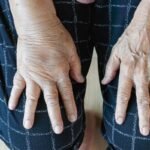Scalp flaking occurs when epidermal cells renew themselves rapidly.
As a result, these cells – which are popularly known as dead skin – accumulate and form layers or scales that can be transparent, whitish, or silvery in color.
This flaking often causes various discomforts, with an itchy scalp being one of the most common symptoms.
When the itching is intense, it often also causes uncontrollable scratching that can lead to the appearance of wounds.
Flakes can also be seen in the hair and on the shoulders, affecting the self-esteem of those who suffer from flaking hair.
In most cases, it is usually due to the presence of dandruff or a dry scalp.
For this reason, it’s common for those who suffer from scalp flaking to try to solve the problem themselves with shampoos or home remedies.
It should be noted that sometimes these methods do not achieve improvement and can even aggravate the problem.
In addition, there are more complex skin conditions that can also manifest with a flaky scalp.
This is why it is essential to know how to differentiate the types of scaling and determine the cause.
Only then can treatment for scalp flaking be initiated to mitigate or eliminate the symptoms.
Causes of scalp flaking
Determining the cause of flakes on the scalp can be difficult without the help of a dermatologist.
Beyond dandruff and a dry scalp, flaky hair can also be a symptom of other conditions such as seborrheic dermatitis, atopic dermatitis, psoriasis, a fungal infection, or actinic keratosis.
Dandruff
The origin of dandruff on the scalp is not fully understood. What is known is that it has nothing to do with poor hygiene, although this can aggravate the condition.
These scales can also form in other hairy areas such as the eyebrows, beard, and mustache.
It is a common condition and can be recurrent, with periods of remission.
It differs from other scaling processes because it presents with an absence of irritation and inflammation (erythema and edema).
Dandruff usually improves with the use of a scalp shampoo and does not require medical attention.
However, if the problem persists, you should consult a dermatologist to rule out that it is not a symptom of another condition.
In the case of dandruff and itching , itching must also be treated to prevent scratching and the formation of wounds.
The itching caused by dandruff can be intense, especially days after washing.
Scratching is common at night and unconsciously, so applying products to relieve scalp itching can help prevent the appearance of small wounds, which can become infected.
Dry scalp
A dry, flaky scalp can be a result of frequent washing, overly detergent-laden shampoos and hair products, or repeated hairstyling processes (hairdryer, bleaching, dyeing, etc.).
In these cases, the scalp becomes irritated, red, itchy, and flaky.
Cold and dry climates also promote dryness of the scalp, as does excessive exposure to the sun, wind, and sea or pool water.
Other causes of dehydration in this part of the body may have a genetic origin or derive from the general state of the body (illness, stress, use of medications, etc.) and lifestyle (low fluid intake, very restrictive diets, etc.).
In any case, the treatment for dry scalp involves choosing gentler, preferably hypoallergenic, hair products.
At the same time, any itching that may occur should be treated with specific products for scalp itching.
Seborrheic dermatitis
Seborrheic dermatitis is a chronic skin condition that usually appears between the ages of forty and seventy, affecting men more than women.
The causes of seborrheic dermatitis are unknown, but it has been linked to the increased presence of certain microorganisms on the scalp.
Emotional stress, cold climates, and low humidity often aggravate their symptoms.
These are usually characterized by the presence of severe dandruff plaques and thick oily crusts ( yellow crusts ) that are accompanied by scalp redness and itching.
Seborrheic dermatitis can also affect the eyebrows, nasolabial folds (the lines that run from the sides of the nose to the corners of the mouth), ears, and trunk.
Other possible manifestations are blepharitis and onychodystrophy (an alteration in the shape or structure of the nails).
Being a chronic disease, it is common for it to occur in outbreaks of seborrheic dermatitis, especially in the autumn and winter months.
Treatment usually involves the use of specific shampoos or hair products containing salicylic acid or active ingredients such as selenium sulfide, zinc pyrithione, or cicloprirox olamine.
Other topical drugs that can be used are calcineurin or topical antifungals, the most commonly used being ketoconazole 2%.
When these treatments for seborrheic dermatitis are insufficient, low-dose isotretinoin can be used.
Beyond dandruff, dehydration and conditions such as seborrheic dermatitis, psoriasis, or eczema can cause flaking of the scalp.
Cradle cap
Seborrheic dermatitis can also occur in babies in their first months of life. In these cases, it is known as cradle cap .
This condition doesn’t cause hair loss or itching. The inflammation is mild and usually resolves on its own.
In addition to the scalp, seborrheic dermatitis in babies can also affect the face and diaper area, and can spread to other parts of the body.
Washing your baby’s head with a mild baby shampoo should be enough to gradually remove cradle cap from the scalp. You can also remove the scales with a hairbrush or toothbrush.
If cradle cap persists, your pediatrician may prescribe low-strength topical corticosteroids or an antifungal shampoo if a fungal infection is suspected.
Atopic dermatitis
Scalp scaling can also be a symptom of eczema or atopic dermatitis.
Although this skin condition is more common in children, atopic dermatitis in adults affects between 3 and 10% of adolescents and adults.
Symptoms of scalp eczema include flaking, dryness, irritation, redness, itching, and burning.
Depending on the severity of the scalp eczema, treatment will vary. Generally, mild shampoos and warm water should be used for washing hair.
In the case of a moderate or severe outbreak of atopic dermatitis on the scalp, medicated shampoos, topical corticosteroids, and even immunomodulators may be prescribed.
Psoriasis
Psoriasis on the scalp affects between 50 and 80% of people who suffer from this skin condition, making it the most common location.
This skin condition is characterized by the appearance of thick, red, itchy patches on the scalp, covered with silvery scales, along with scaling very similar to dandruff.
Seborrheic dermatitis and psoriasis can be confused because they share some symptoms.
However, psoriasis scales are usually thicker and drier than those of seborrheic dermatitis.
Additionally, psoriasis tends to spread beyond the hairline and affect more than one area of the body.
Treatment for scalp psoriasis involves the use of hair products containing keratolytic agents such as salicylic acid.
Sometimes, the use of topical corticosteroids, calcineurin inhibitors, retinoids, and tars may also be necessary.
Sunbathing and phototherapy have also been shown to be effective as adjuvant therapies.
In cases of psoriasis and severe scalp scaling, systemic treatments may be prescribed.
At the same time, gels for scalp itching will help soothe the itching and prevent scratching.
Fungus
Dandruff and scalp fungus can be directly related.
Fungal infections can cause itchy, red patches, dandruff, and flaking, and even temporary hair loss in the affected areas.
It is what is known as ringworm of the scalp or scalp.
This condition is much more common among children and may be one of the causes of dandruff in children.
Unlike other causes of scalp flaking, fungal dandruff is highly contagious. Therefore, it’s best to treat it as soon as possible.
Treatment for ringworm of the scalp usually consists of oral antifungal medications, usually terbinafine, griseofulvin, or itraconazole.
To prevent its spread, antifungal creams are also applied to the scalp until the infection is cured. 2.5% selenium sulfide shampoo is also often prescribed twice a week.
In adults, a short course of corticosteroids, such as prednisone, may also be indicated to relieve symptoms and prevent scarring.
Actinic keratosis
Actinic keratoses are rough, dry, scaly patches that appear due to accumulated sun exposure. This makes them more common in older people.
They can come in a variety of colors, including pink, red, or brown.
These spots or patches may be accompanied by itching, burning, bleeding, or scabbing.
Because these are scaly lesions, actinic keratosis is another possible cause of scaling on the scalp.
Treatment may range from applying a hair gel with a keratolytic effect to cryotherapy, topical chemotherapy (5-fluorouracil), or other procedures such as immunomodulators.
If left untreated, actinic keratoses run the risk of developing into squamous cell carcinoma, a type of skin cancer.
Therefore, knowing why your scalp flakes is not only necessary to combat dandruff and flaking, but also to prevent more serious complications.





















+ There are no comments
Add yours